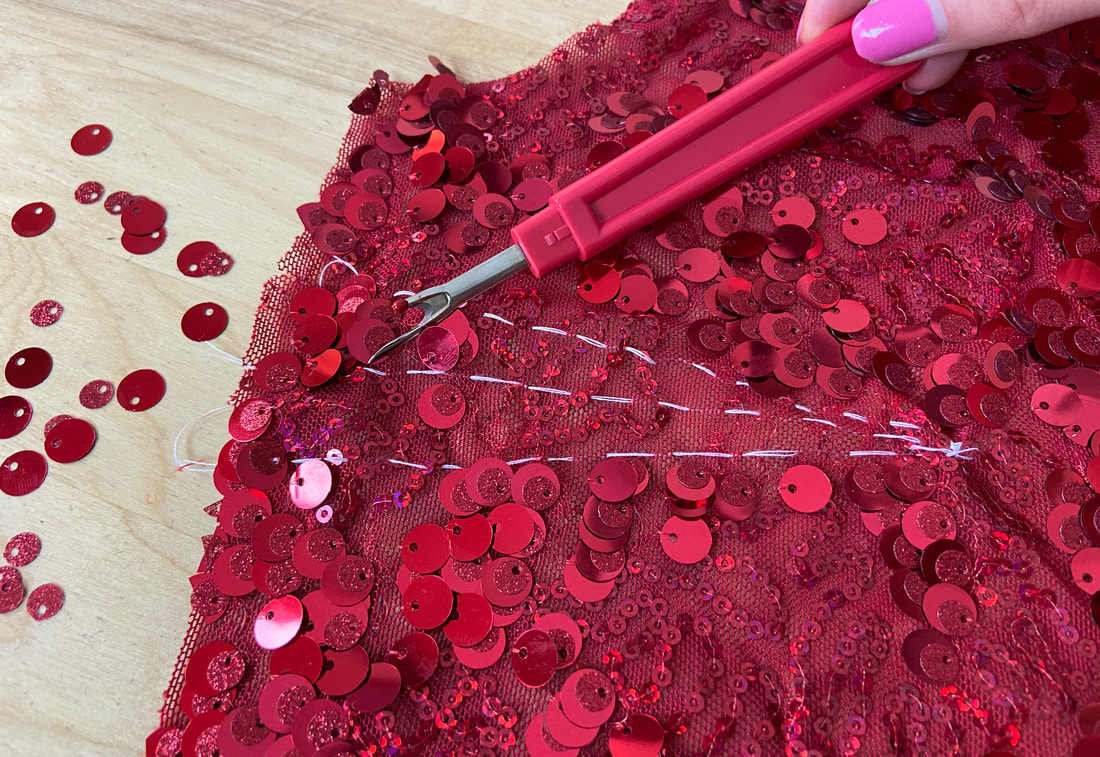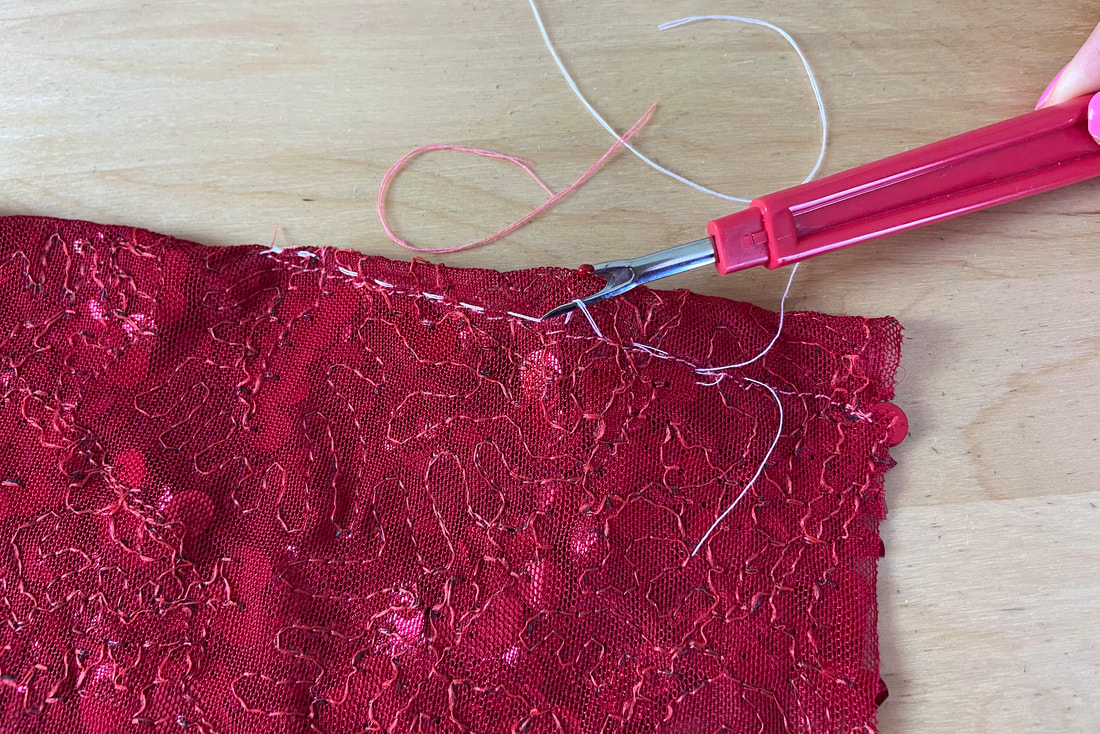Marking and sewing darts is for the most part, fairly straightforward: The dart lines are transferred onto fabric using a preferred (or required) transfer method, after which the dart is folded and stitched following these transferred lines.
As with anything in dressmaking, fabric always creates a special circumstance. That being said, what happens when your project leads you to sewing darts into heavily decorated fabrics? Decorative fabrics are those featuring beading, sequins and other applique elements.
In this case, if you attempt to sew a dart using conventional steps, you will run into a few problems:
- The dart will be difficult to transfer from pattern onto fabric. You can only use regular or simplified tailor tacks or hand basting in the dart marking process.
- The dart may be difficult to fold due to the heavy decorative elements. Once folded, the dart lines may not align properly.
- The dart will be difficult to machine stitch. You run the risk of breaking or damaging your needle as it attempts to stitch though decorative elements like beads or multiple layers of sequins.
- If the dart is successfully stitched, it will most likely not lay flat catching the decorative elements within the seam. This creates not only tension but also bulk issues.
- Even if the dart excess is trimmed to release tension and minimize bulk, the layered decorative elements within the remainder of the dart excess will still not allow the dart to lay completely smooth and flat.
To avoid all the issues described above, there is a simple preparation step you can follow right after the dart has been transferred to fabric.
Prior to folding and stitching the dart, remove as many of the decorative elements from within the excess of the dart. This technique, as well as how to machine stitch the dart safely, are described in more detail below.
First and foremost, let’s discuss the marking method used to transfer dart lines from your pattern onto a heavily decorative fabric.
Tracing paper and tailor’s chalk are no good here as the lines will simply not show through. These techniques may even damage and stain the fabric surface.
For this challenge, you will need to use a safe dart transfer technique that shows both on the face and wrong sides of the fabric.
Tailor tacks or hand basting are perfect in this instance. These fast hand sewn marks are visible throughout the sewing process and easy to remove once no longer needed.
In this example, we’re using simplified tailor tacks followed by hand basting to transfer all dart lines.
1. Before aligning and pinning the pattern, place the fabric flat on the table with the decorative elements facing up. Pin and cut the patterns.
After the pattern has been cut, use the simplified tailor tack method to transfer the dart lines from the paper pattern onto the fabric underneath. This should be done prior to unpinning and separating the pattern. For detailed steps on applying tailor tacks, check out this tutorial: Marking And Transferring Darts To Fabric
When the pattern is removed, the tailor tacks will be visible on both the face and wrong sides of the fabric. The tacks should be distributed densely enough to see the defined shape of the dart and its stitch lines.
2. Following the tailor tacks as a guide, replace them with hand basting to create more defined lines. Remove the tacks once the basting is completed.
3. At this point, use a seam ripper or fabric scissors (a smaller pair will work great here) to remove all decorative elements from within the dart excess only.
If removing sequins or beading, use a seam ripper and work carefully to remove each one individually.
If removing excess high pile from the fabric surface, use your scissors to trim the pile within the dart excess as low as you can get it. Be very careful not to accidentally remove the marked dart lines as they are very important in the dart stitching process.
Once all decorative elements are removed from within the dart excess, you should have a clearly defined dart shape that is flat and bulk free.
5. Following the hand basting that marks the center line, fold the dart from the wrong side such that the two dart stitch lines on each side overlap and match up perfectly. This should be fairly easy to do now that the decorative elements are removed. Insert a few pins to keep the dart folded
6. Hand baste next to the dart stitch line marked by the initial basting. The dart stitch line should be a completely straight line which starts at the wide portion of the dart and ends at the dart point or vanishing point.
At this point, if you attempt to stitch the dart using a regular presser foot you will be unable to feed the fabric through. That’s because the decorative portion located to one side of the dart lines will align underneath half of the presser foot as you stitch. For that reason, you will need to use a zipper presser foot to properly machine stitch the dart.
A zipper presser foot is about half the width of a regular presser foot. It aligns the machine needle either to its left or its right side. The beauty of this half presser foot style is that it allows you to stitch right next to raised edges or elements that would otherwise not fit under both sides of a regular presser foot.
7. To stitch the dart, align the zipper presser foot such that the needle corresponds to the right side of the decorative surface, and right on top of the marked dart line.
Starting at the wider portion of the dart, and keeping the needle on top of the dart stitch line (and adjacent the decorative surface), stitch carefully until you arrive at the dart vanishing point.
8. Using a seam ripper, remove all hand basting at this point.
Do not backstitch at the dart point. Instead, leave enough loose thread to tie a knot at the end of the stitch.
Last but not least, what can we do with that dart excess? Due to the heat sensitive nature of almost all decorative fabrics, you will most likely not be able to iron the dart excess.
To keep it pointing in a single direction, use a slipstitch to secure the dart fold line to the fabric surface.
The slipstitch will keep the dart excess flat and pointing down on the wrong side of the garment while being invisible on the garment's right side.
If you look on the application's face side, the dart seam should lay flat and blend into the decorative fabric surface.
Note: If the excess is adding undesirable bulk, you can trim it about ½” away from the dart stitch line and slipstitch the excess either down (horizontal darts) or toward the center (vertical darts) based on type of dart.





















